Articles
Training, Restraining and Sustaining:
Infant and Child Care in the Late Nineteenth Century
Cette étude examine certains facteurs qui ont exercé une influence déterminante sur les appareils d'apprentissage, de retenue et de support des nourrissons et petits enfants de moins de deux ans. Parmi ces appareils conçus pour faciliter la tâche de ceux qui prennent soin des enfants, on retrouve notamment les berceaux, les trotte-bébé, les ceintures et les barrières de sécurité, et les biberons à longue tétine. En outre, l'étude tire des conclusions sur les attitudes historiques à l'égard de la petite enfance et de l'enfance qui sont étroitement liées aux objets étudiés. Elle ne se limite pas au XIXͤ siècle, bien que cette période en soit le point de mire.
Résumé
This paper addresses the implications of and some of the factors behind some training, restraining and sustaining devices for babies and small children, up to about two years old. The devices include cribs, baby walkers, safety belts and gates, and long-tube nursing bottles, along with other artifacts designed to ease the burden of child care. These material objects are connected to historical attitudes towards infancy and childhood. The discussion is not limited to the late nineteenth century, though the period provides a focal point.
1 Scholars writing about the history of childhood often speculate on whether or not a child's life over the centuries has improved. Child labour, routine and harsh corporal, even capital, punishments, declarations on the urgent necessity of breaking the child's will and on infant depravity and damnation — these kinds of things may incline one to view the modern period as one of great progress in child nurture. Evidence from the material culture is also cited. As J.H. Plumb wrote, "Wherever we turn in the world of children-clothes, pets, toys, education, sport, music and art, their world was richer, more varied, more intellectually and emotionally exciting than it had been in earlier generations."1 Lloyd deMause is a leading exponent of the Whiggish school, going so far as to state that "the history of childhood is a nightmare from which we have only recently begun to awaken."2
2 This is in opposition to Phillippe Ariès, whose seminal work Centuries of Childhood has influenced virtually all subsequent scholarship on childhood history.3 Employing some evidence from iconography, children's clothing, toys and games, Ariès concluded that the Middle Ages did not know strict divisions between childhood and adulthood. Children fitted into the whole society, with all its diversity, and were not isolated from it in the bosom of an obsessively child-centred nuclear family which imposed upon them the discipline of long schooling and rigid conformity to special standards and ideals. There is a certain loss of freedom for the child in these developments.
3 Ariès' influence can be seen in this statement:
4 This paper will discuss many of the same objects with the idea that such objects do not just happen — they represent or embody certain ideologies or beliefs, and they have certain implications, for adults as well as children. Research into these objects and their background indicated that the history of infant and child care is not one of steady progression or retrogression. Instead, the line is more like a graph — with ups and downs that sometimes occur simultaneously. If there is a constant in this history, it is that people charged with looking after infants and toddlers have been very much impressed by how demanding and troublesome they are and have tried by various means to reduce these demands throughout human history.
5 One way of reducing the demands of an infant is swaddling clothes, and this solution has been employed for centuries in practically all civilizations (fig. 1). Swaddled infants apparently sleep more and cry less. Their heartbeats slow down, and they are more passive than unswaddled, babies. They are thus less trouble for the care-giver, who has the additional convenience of being able to hang the baby from a nail or peg, or tuck it out of the way like a parcel.5 The babies are protected from cold and drafts, from animals, from injury, and from themselves, but they aren't likely to have been cuddled either — it would be kind of like hugging a rolled-up newspaper. According to family historian Lawrence Stone, the sensory and motor deprivation entailed was one factor in the "psychic numbing" of so many adults in sixteenth- and seventeenth-century England, and the root cause of the country being so cold, suspicious and violence-prone.6
6 The stated purpose of swaddling was to mould the infant's head — to train its limbs and back to grow straight, and to protect it from ripping off its ear, gouging out its eyes, and whatever other depradations it had in mind. Notions of infant depravity and original sin may have had something to do with this treatment, though obviously swaddling occurs in cultures that believe in neither. Still, many Christian writers on infancy seem quite daunted and even frightened by how much an infant resembles an animal — or perhaps the devil — in lack of human skills, and selfish and unbridled desires. Swaddling and moulding its limbs must have made it seem more human — a step away from brutish existence and closer to a state of grace.7
7 Karin Calvert sees swaddling as evidence of adults imposing standards of upright behaviour on babies.8 The practice began to lose favour among the upper classes in England and the colonies in the eighteenth century, though vestiges remained in the use of stays, corsets and backboards for children, and in the bellyband still in use at the end of the nineteenth century.
8 Clearly, a swaddled baby would be less disruptive to an adult society that refused to adapt for its benefit. However, it is difficult to mourn the loss of freedom of the modern child caused by the strong division between adulthood and childhood, when what is gained is the freedom to move a muscle.
9 The same could be said of the drugged child — another ancient and almost universal way of keeping babies quiet and reducing their demands. A 1472 book on infant diseases by Paolo Bagellardo stated: "Our common people give infants a little of the stuff called Quietness, a decoction, or boiled down extract of poppy seeds." Nineteenth-century writers on infant care railed against this practice-apparently not limited to "common people" — and in the face of a variety of commercially produced "soothing syrups." A 1912 report on infant mortality in Ontario listed some of them and their major components:
Dr. Fowler's strawberry and peppermint mixture — morphine;
Victor Infant Relief — chloroform and cannabis indica;
Dr. Jame's Soothing Syrup — heroin.10
Many drugged babies died in the attempt to have them conform to adult standards of behaviour and fit into adult life.
10 Another restraining practice was the tying or lacing of infants into a cradle. Even swaddled infants might be subjected to this. Once swaddling and lacing were abandoned, cradles were destined to accommodate a more active child. This probably affected their design, as did, apparently, expert advice on rocking and fresh air. Karin Calvert's essay sees the disappearance of the cradle hood or canopy and its traditional solid construction giving way to slats or spindles as the result of all the promotion of fresh air and cool temperatures by such influential writers as John Locke and Dr. William Cadogan. Similarly, cradles went "off their rockers" because rocking was vehemently denounced as productive of brain damage and other derangements by a host of nineteenth-century paediatric experts.11
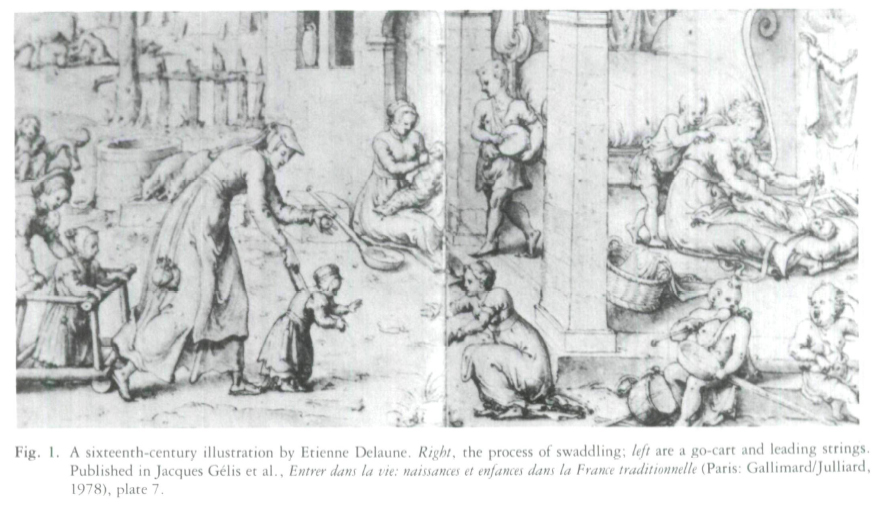 Display large image of Figure 1
Display large image of Figure 1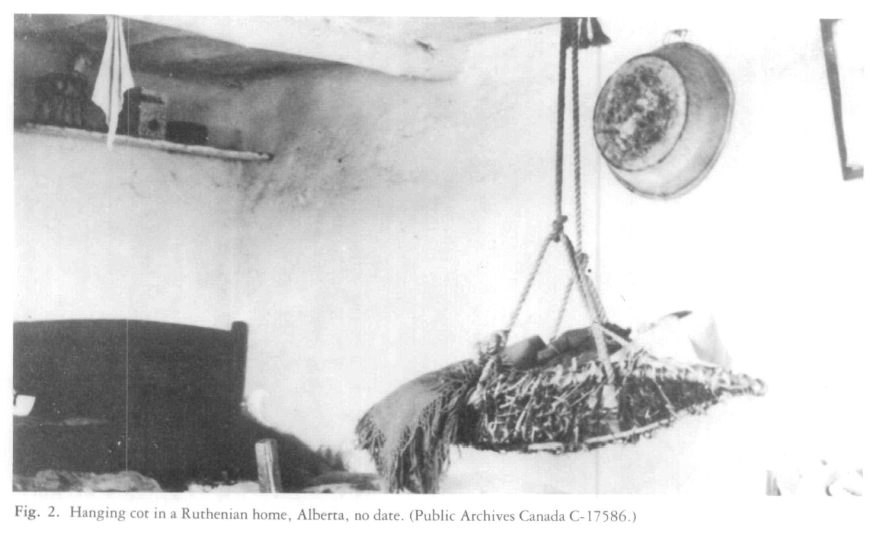 Display large image of Figure 2
Display large image of Figure 211 The cradle lost its raison d'être and by the end of the century gave way to the crib. This did not mean that everyone who had a baby had a crib or that not one cradle was in use on the face of the earth. Rather, the advice was probably relevant to a group of middle- or upper-class people who considered themselves in the know. Among these were some urban fresh-air enthusiasts, who early in this century hung baby cots in wire contraptions out of windows. One of them was Eleanor Roosevelt who was threatened with the Society for the Prevention of Cruelty to Children by agitated neighbours who may well have kept their babies in hooded, solid-sided cradles with rockers.12
12 Another type of cradle (fig. 2) — swung to quiet a turbulent infant and perhaps conveniently hanging near its mother's bed — may not have been widely accepted by the English-speaking middle classes, given the lack of evidence concerning its use.
13 In the United States portable wicker bassinets were less in vogue than bassinets that hung from a stationary stand — like display or presentation cases — highly appropriate in an era of "His Majesty, the baby."13
14 The evolution from cradle to crib may not be a glowing chapter in the history of human progress. Toddlers in cribs are likely to require less attention and, when they cannot climb out, can be left in them for a long time. In spite of the century's poetry and images of idealized babyhood,14 day-to-day child care remained a source of fatigue and bother.
15 Cribs, especially cast-iron ones with hygienic mattresses, were a product of a germ- and science-conscious period. They also served to keep babies away from other people. A crib, unlike a cradle, is not likely to be moved around the house or outside it (fig. 3). Cribs are also an encouragement to have babies sleep alone. While in the seventeenth and eighteenth centuries babies apparently slept in their mothers' beds, and after that with siblings or someone else, many nineteenth-century baby-care writers were emphatically against this practice.15
16 Catharine Beecher's 1873 Housekeeper and Healthkeeper states "It is better for both mother and child that it should not sleep on the mother's arm at night, unless the weather be extremely cold. This practice keeps the child too warm and leads it to seek food too frequently "16 Isabella Beeton, however, offered a long list of injunctions and evil and dire effects:
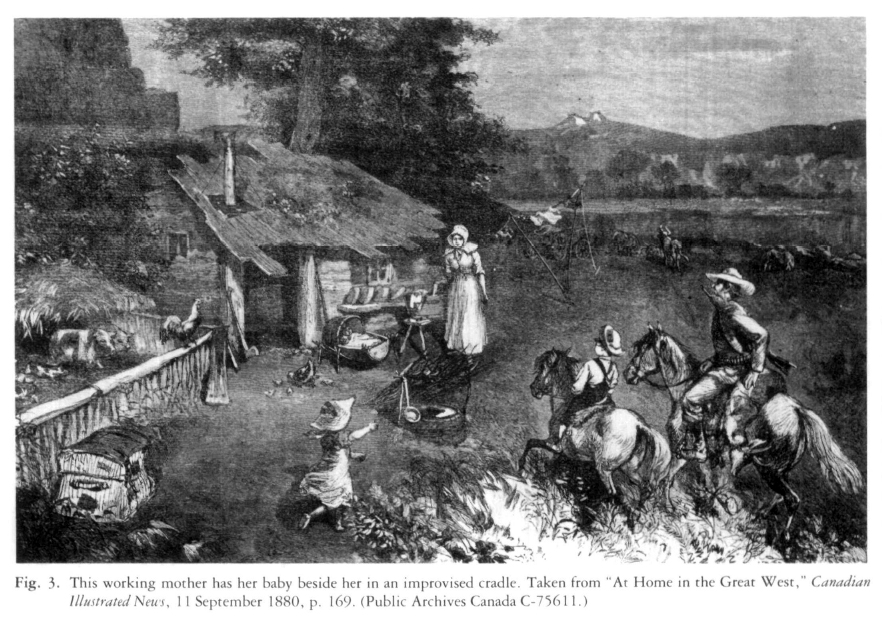 Display large image of Figure 3
Display large image of Figure 317 Mrs. Beeton continued to warn against the practice by conjuring up an amazing picture of the consequences of an infant sucking its sleeping mother — It imbibes "a fluid sluggishly secreted and deficient in those vital principles." The mother will wake...
18 Many experts warned of the accidental overlaying, or suffocating, of the baby if mother and baby shared a bed. However, there was some tolerance in the books consulted for the baby being in the mother's room — in a crib or cradle beside her bed. Loudon's 1839 Encyclopaedia of Cottage, Farm and Villa Architecture described cribs as "generally intended to be placed, during the night, by the bedside of the mother, and for the purpose, the height of the crib should correspond with that of a large bed and one of its sides made to lift out." He added, "swinging cribs and cradles are now justly exploded."19
19 Figure 4 is an advertisement from a 1903 Newfoundland Quarterly illustrating the compromise between the infant sleeping alone and with its mother. One baby-care writer would have none of this: she maintained that the baby's instinctive knowledge that there was a breast in the room kept it awake.20
20 According to Karin Calvert, cribs soon acquired a room of their own, and nineteenth-century middle- and upper-class babies were isolated, in an unprecedented way, from the rest of the family in the house.21 This is more likely to have happened in homes following some expert nineteenth-century advice on how to teach babies that they cannot get their way by crying.
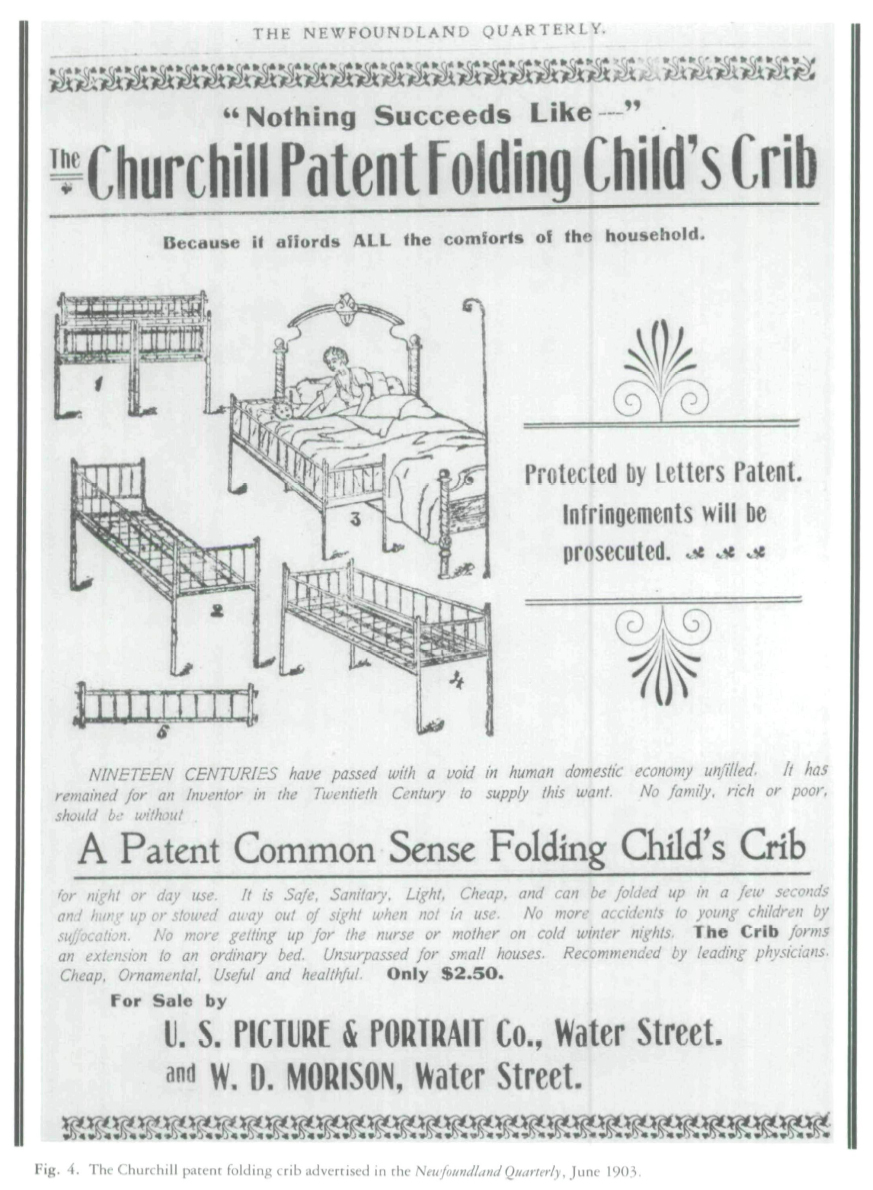 Display large image of Figure 4
Display large image of Figure 4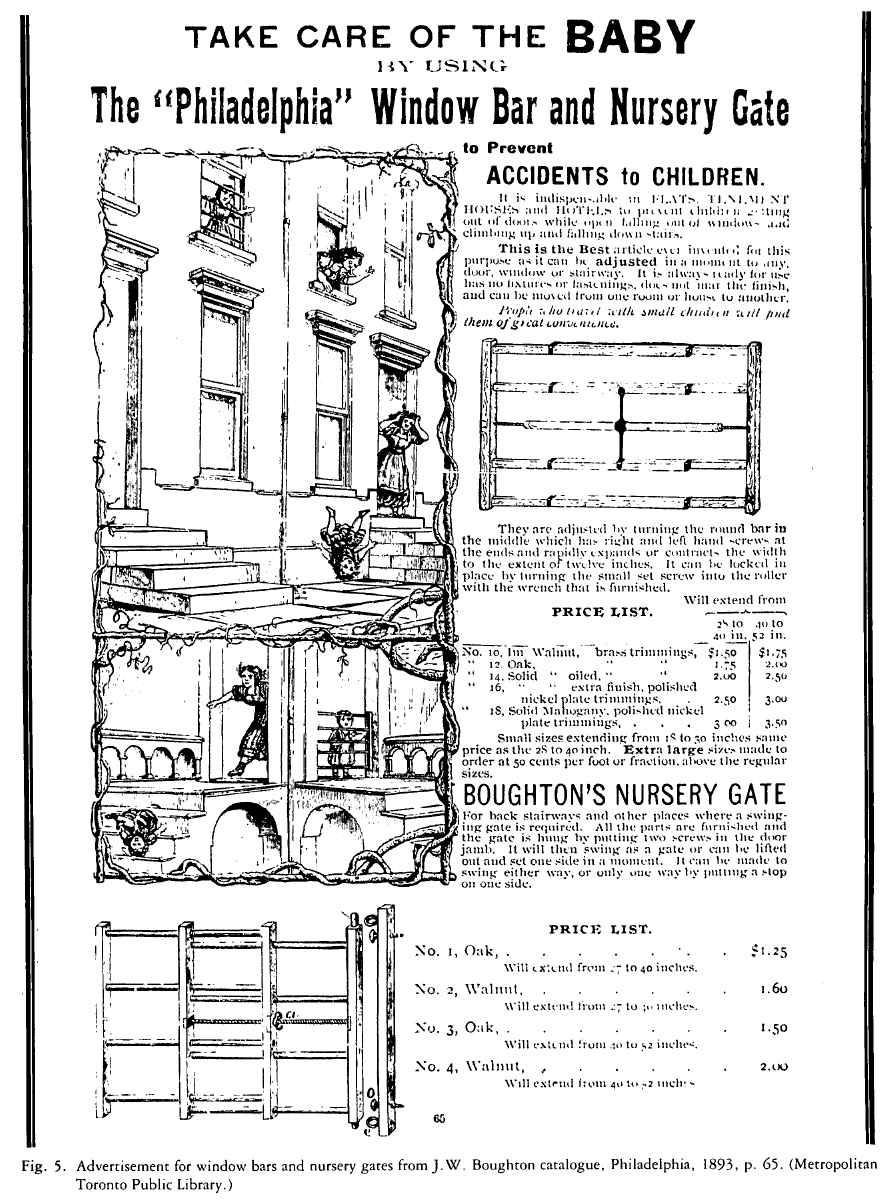 Display large image of Figure 5
Display large image of Figure 521 Other "scientific" advice may have encouraged the isolation of the child. Medical experts deplored the genital stimulation that might occur with more than one in a bed. So horrendous were the wages of masturbation and sin — chronic physical and mental disease, even death — that metal mittens appeared — so did advice to tie the child's hands to the bed. By comparison, a "pre-modern" child (when not swaddled) seems to have been freer of such restrictions and accumulated guilt.22
22 It can be argued that special rooms for children recognized the importance of the early years of life and the unique qualities of childhood — the innocence and vulnerability to which Victorian writers so frequently attested.
23 Advice mongers wanted nurseries to be places of edification and moral training for the little darlings, no longer considered to be "depraved vipers" but inclined to good and imbued with visions of heaven. Nursery decoration should be, then, "an object lesson in simplicity, refinement and harmony of colour" and pictures hung with a view to "expand and elevate" the mind.23
24 But not only the mental and moral well-being of the child was at stake in these special rooms. Children, the experts tended to maintain, had different physical requirements to those of adults. They needed a great deal of fresh air, cool temperatures, open fireplaces, nor stove or steam heat, and in the germ-conscious 1880s and 1890s, it was particularly crucial for them to live within walls painted in distemper with minimum of or no carpets or curtains, no furnishings that would gather dust and harbour disease. Pye Henry Chavasse, M.D., advised mothers in the 1889 edition of his popular manual to use candles, no gas or paraffin lighting, in the nursery.24 He warned against the use of green paper hangings there as they contained "large quantities of arsenic...which flies about the room in the form of powder." Further, small children might put in their mouths any paper that came loose: "four children in one family have just lost their lives from sucking green paper hangings."
25 Though the impetus for setting aside rooms as nurseries may have been a recognition of the special moral status and innocent characteristics of childhood, it seems that views of paediatric and other authorities on hygiene and child health must have provided a stimulus as well.
26 This is not to say that most people followed the advice in the manuals or that most homes had nurseries, but there must be some explanation for the existence of any nursery. Not to be overlooked as a motivating factor is that parents did not wish to be bothered by their children, and they could accomplish this free of guilt, in an admittedly child-centered age, by following such advice and constructing a special, separate and hygienic world for the child.
27 A late nineteenth-century manual made explicit the parental wish to lead separate, adult lives by quoting "a fine lady":
28 Bars on nursery windows were not a figment of her imagination. Sources consulted referred to "windows guarded without by an iron net-work," "large open gratings fixed over the doors" and "wicket gates" on stair landings (fig. 5).27 References to and pictures of fire guards can also be found (fig. 6). Chavasse advised that they be large enough to go all around the hearth, and sufficiently high to prevent a child from climbing over. In fact, he thought, each room in which a child was allowed "should be furnished with one on the bars."28
29 Did the concept of child-proofing exist even earlier, in the eighteenth century? Karin Calvert thinks not:
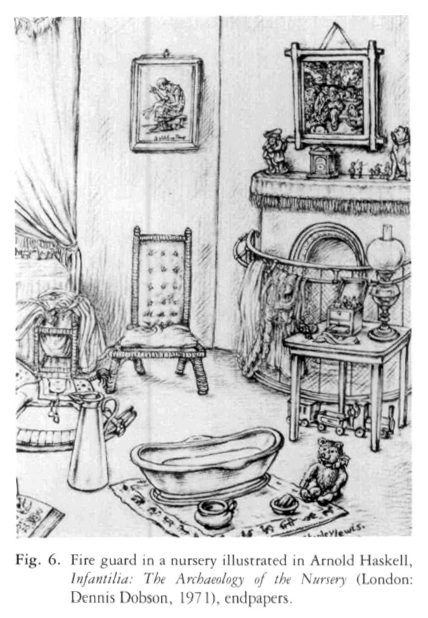 Display large image of Figure 6
Display large image of Figure 630 This may be overstated. Simply because it is difficult to find evidence of such precautions, does not mean that they did not exist. Further, Peter Gregg Slater in Children in the New England Mind makes a case that one should not judge by our or by Victorian standards expressions of grief and caring by colonial New Englanders. Because they did not wallow in it or put a premium on self control, does not mean they did not grieve or care.30
31 Playpens were marketed to the middle classes in the 1890s as if they were a novelty. An advertisement from an 1891 Ladies Home Journal states that the playpen ("Mother's Baby Guard") is "better than a nurse." The message implies a shortage of trustworthy and acceptable domestic servants to mind upper- and middle-class children. A cage was more reliable and free of unsavoury habits and disease.31
32 One reference to a much earlier version of a playpen is in a quote from a 1473 book A Regimen for Young Children: "When children begin to creep around the floor and reach after things, one should make for them a little pen of leather so that they do not hurt themselves."32 Not only nineteenth-century children lost their independence for the sake of safety!
33 The quote is also interesting for its apparent acceptance of creeping. It is maintained that before the nineteenth century most parents did not approve of it. It was too animal-like, reminded everyone of baser instincts, dirtied children's clothes, and really, had no redeeming value.33
34 This attitude inspired the various devices to teach children to walk — the standing stool or go cart, as well as leading strings. Go carts or standing stools have been around for centuries (see fig. 1).34 Unlike modern walkers, these have no seats and force the baby to remain standing. Leading strings have some counterpart in modern harnesses, although the former apparently were used to compel the child to stand upright rather than just keep him or her nearby and off the street (see fig. 1).
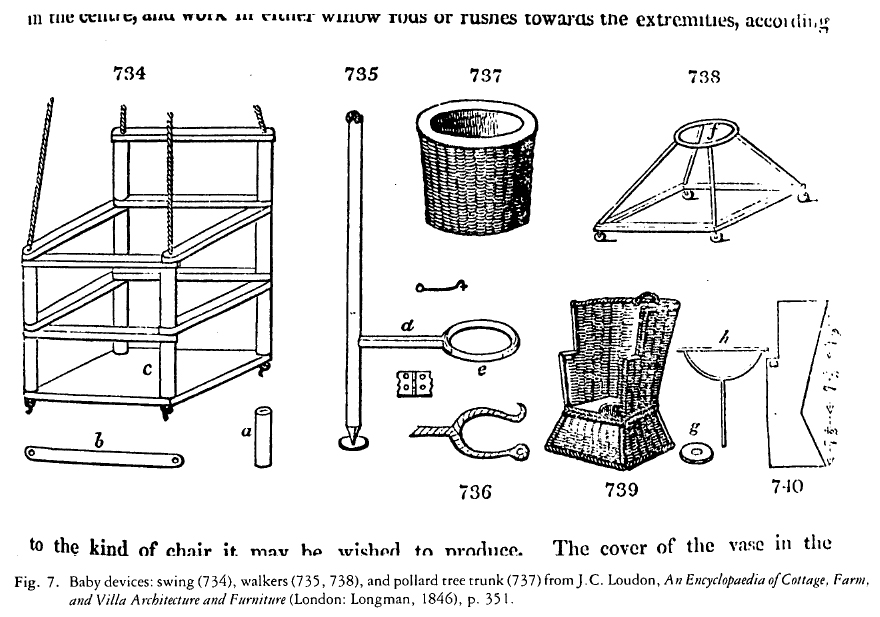 Display large image of Figure 7
Display large image of Figure 7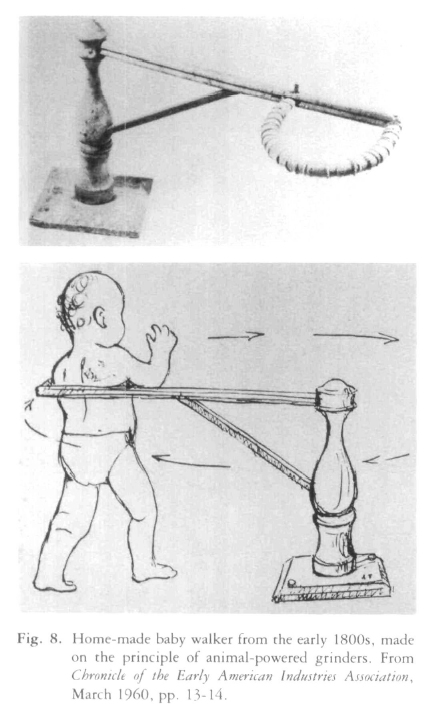 Display large image of Figure 8
Display large image of Figure 835 Karin Calvert asserts that go carts and leading strings show that childhood was not recognized or appreciated and that children were obliged to approximate adult behaviour as soon as possible. When attitudes to childhood changed, and children's stages and limitations were recognized, Calvert says that walkers gave way to swings and jumpers. This must have pleased paediatric experts, most of whom deplored standing stools and leading strings as cruel, if not deforming. They may have given way, but baby walkers and encouragement to walk or stand early did not disappear.36 Some home-made models must have been constructed by someone trying to break a child's will (figs. 7, 8). The objects illustrated in Loudon's Encyclopaedia (fig. 7) "are made in England by every cottager for himself." One he describes as "a hollow cylinder, nothing more than the section of the trunk of an old pollard tree.... The inside and the upper edge are smoothed, and a child just able to stand is put in it, while its mother is at work by its side, or going about the business of the house."37
36 Loudon also illustrates a swing chair that could be adapted for an infant of the "earliest age." Not only could swings be employed for babies too small to go in a standing stool, but they would have kept children passively and safely confined to one spot, and perhaps out of adult company.38 A child in a swing or jumper required less attention and probably complained less than one tottering about in a seatless go cart or on leading strings or confined in a pollard tree trunk. The measure of entertainment provided by these devices would have encouraged parents to feel that they were doing something for the child, rather than confining and isolating him or her.
37 Why might late nineteenth-century parents have been generally keener than some of their predecessors in accomplishing this? Well, for one thing, demands on middle-class women are increased during the cult of domesticity and motherhood, because household cleanliness and order, along with child-rearing standards, are raised.39 At the same time, servants and helping neighbours may be more difficult to come by, and children of an age to mind babies and help with domestic work are away at school. Still, there are a few devices such as the baby and child bicycle carriers advertised in the 1897 Sears Roebuck catalogue, that express some parental desire to involve small children in adult activities.
38 A high chair allowed a child to sit at an adult-sized table and participate in adult life, especially those models which were drawn up to the table and had no swinging tray. Though high chairs have existed in Western culture since the sixteenth century, apparently very few colonial children sat in one.40 Instead, they ate standing at the table, or seated on the floor, or on whatever furniture or adult lap was handy.
39 Very free and easy and informal, such seating arrangements, compared with the restrictions of a high chair with a tray and safety straps. Manufactured straps, of course, are not the only solution to confining a child in a chair, and such devices do pre-date the Victorian period (fig. 9). Safety straps and bars are not bad things. They recognize the child's limitations and show concern for his or her safety and comfort, as do footrests which became more common after the middle of the century.
40 The swinging tray, another late century development confined the child, closed access to the family table, and gave adults better control over what food he or she reached for. If adults followed paediatric advice on diet for children, this as well set them apart from the rest of the family. In some cases, children up to six or even ten years old were to live on a very restricted diet of bland, rather gruesome combinations of broths, cereals, overcooked vegetables and fruit (only certain ones), and so on.42
41 High chairs may be more significant in North America than in England as apparently middle-class children in the United States regularly participated in family meals and English children did not. An English writer on nursery furniture went so far as to declare:
The author did not speculate on why this might be so.
42 Fine furniture for American children no doubt was the exception rather than the rule. Late in the century, children's furniture makers, like other Victorian manufacturers, seem to have been conscious of the appeal of novelty. Perhaps capitalizing on a rage for space saving and efficiency as well as the popularity of such new items as swings and jumpers, a high chair that could convert into a rocker was markered. Some models also served triple-duty as a carriage (fig. 10). Another new item in the 1850s was a combined high chair-jumper, whose seat could be bounced up and down.44 Some late nineteenth-century high chairs also had built in potties.
43 In being forced to evacuate in a potty or on a chair, the nineteenth-century baby, and not its earlier counterpart, had to imitate adult behaviour to win approval. While a swaddled baby had nearly every other movement restricted, adults probably did not consider trying to control its bowels. Not only was it a big bother to keep binding and unbinding the baby, but public and private hygiene do not seem to have been a general priority. But from about the 1840s very early toilet training, sometimes as early as two months, was being insisted upon by some manual writers. Evidence for this can also be seen in a chamber pot with a diameter of 12.5 centimetres (5 inches).45
44 Behind this, no doubt, were the nineteenth-century attitudes of a revulsion towards filth and natural urges and an obsession about hygiene and constipation. The apogee of this drive to control children's bowel movements must have been reached when L. Emmett Holt's Care and Feeding of Children suggested the introduction just inside the baby's rectum of an oiled paper cone or a piece of soap.46
45 Compared with earlier babies, those born in this period may have been more physically isolated in playpens, swings, cribs and so on, and more often ignored, but other areas of their lives were receiving unprecedented attention — their bowels, along with their emotional and social development. In this sense, the late nineteenth-century or early twentieth-century baby had less privacy; in general he or she was under intense scrutiny from scholars in psychology, early childhood education and paediatrics, especially during the period of the child-study movement.47 Governmental agencies were also focusing on infant and child welfare. All this attention on special needs and stages and on the differences between children and adults set children off from the rest of society.
 Display large image of Figure 9
Display large image of Figure 946 Another late nineteenth-century development was the manufactured pram or baby buggy. This caused fundamental changes in the lives of babies and those who looked after them. They seem to have been used by all classes in society, whereas cribs, high chairs, jumpers and so on were probably quite uncommon below the level of middle-class.
47 More than other devices and furniture for children, baby carriages served as indexes, for all to see, of the stylishness and prosperity (or at least the aspirations) of late nineteenth-century families. Various models were as overdecorated as a Victorian parlour.
48 Baby carriages are also evidence of a child-centred culture, displaying to best advantage in so many family pictures like "a jewel on a velvet tray" the baby, the ultimate symbol and focus of domesticity and motherhood.48
49 Before the advent of the mass-produced baby carriage children who needed to be carried probably did not often venture far from home, and certainly not with the elderly or infirm, or young siblings. There were exceptions, of course, notably in Amerindian culture. Similar carrying devices may have been used in France and in Ireland when Elizabeth Godfrey's English Children in the Olden Time testified, "a very queer form of cradle seems to have been in use...a kind of pendulous satchel with a slit for the child to look out of.... "49
50 English hop pickers were known to have trundled their children to work in hop wagons. Like these, the earliest children's carriages were pulled rather than pushed, had neither upholstery nor springs, and often risked the child falling out unnoticed.50
51 Pram and carriage manufacturers seem to have responded to a need for safer, more comfortable vehicles. From about the 1880s suspension springs, adjustable safety belts, canopies, upholstery (which sometimes almost swallowed the child) and relatively stable and deep bodies were quite standard. Automatic brakes, though repeatedly patented, failed to find favour with consumers.51
52 Some domestic advice books stood solidly against baby carriages for a reason manufacturers could do nothing about, short of equipping the vehicle with a sensing device and the mother with radar. It was the hazard posed by the low-class nursemaids in charge. They could easily transport the little innocent to the degrading slums and dens of vice they frequented. As well, they were likely to recklessly jolt their charges over bumps and rush them down slopes, imperilling spine and brain. Babies in buggies might be forgotten or left outside, exposed to drains and contagious diseases, wind, weather and other horrors.52
 Display large image of Figure 10
Display large image of Figure 1053 A baby's geographical mobility and the range of visual and sensory experiences were dramatically increased by prams and carriages, and perhaps there were an increasing number of pleasant places to take babies on wheels — more parks, more pavement, more suburban strolls.
54 However, this also meant that babies and toddlers were held less — all the better, thought some medical authorities, because this ruined women's spines.
55 Baby carriages, therefore, increased the separation between the adult and the child and reduced the strain of bringing up baby. Since the baby is getting fresh air and stimulation, and in an up-to-date product of a modern age, the parent could feel virtuous about pacifying the child with long walks requiring minimum adult involvement. Often, the adult could not even catch a glimpse of the occupant, in carriages pushed from behind and with obstructing canopies and umbrellas.53
56 The kind of distance and reduction in physical contact brought about by baby carriages, along with cribs, jumpers and playpens, was seen to be a good thing by many medical authorities who thought that too much carrying about and attention would ruin the baby's health, brain and character. An extreme example of this attitude was held by L. Emmett Holt, whose Care and Feeling of Children, first published in 1894, was in its fifteenth edition in 1937. These quotes are from a 1918 Canadian edition:
57 If they followed this advice, the late nineteenth-century parent was more restricted than their eighteenth-century counterparts, who presumably kissed or played with their children if or when they felt like it.
58 Parents in the modern period have to some extent abrogated their decision-making powers to scientific experts. The special responsibilities assumed by the medical profession over the normal care of the healthy child finds parallel in the history of childbirth and midwifery. Women and lay people lost control over childbirth and child care, being supplanted by specialized males and hospital procedures. This was applauded as early as Dr. William Cadogan's 1748 Essay on Nursing:
59 Cadogan's expertise was derived at London's Foundling Hospital. His solutions, and those of many paediatric specialists, were based on institutional experiences, where a small staff cared for a number of infants. Minimum attention, a constant spectre of death, antiseptic scrubbing, food at carefully timed intervals, and the tolerance of a lot of crying were applicable to such places, but transferred to the home, such procedures may not have been in the best interest of one infant.56
60 Sixteenth- and seventeenth-century babies, whose wills apparently needed to be crushed and who were candidates for hell-fire, were fed on demand. As the 1584 poem recommends:
This nature teaches best the nursing tribe.
Let her your mistress be, and when, with cries
The hungry child demands his due supplies
Forbear not you the wish'd relief to bring
But for his use, unlock the sacred spring...57
61 Some of the most ferocious rigidity in feeding and sleeping schedules were imposed, not in the "strict" Victorian period, but in our "permissive" twentieth century. Such schedules may have been a modern version of crushing a baby's will.
62 The training of babies to sleep and eat by the clock may be another aspect of the kind of time-discipline that is a feature of modern industrial capitalism. An externally imposed system of time schedules that have nothing to do with rhythms of nature drew women and babies out of the conventions of a pre-industrial society, where time measurement was not a basis for human activity. Perhaps babies on such schedules will internalize this discipline and will follow other people's schedules and for the benefit of others all their lives and without question.58
63 While feeding schedules were probably supposed to make life easier for the care giver, they probably contributed to some sense of alienation, especially for a mother whose baby refused to go by the book. Her resentment must have been compounded by the requirement to adore the little cherub. Perhaps eighteenth-century mothers did not feel as guilty when they resented their little "vipers."59
64 There were at least two other artifacts of childhood relating to feeding that increased the distance between mother and baby, while restricting its demands and supposedly rendering its care less burdensome.
65 One was patented infant formula, whose makers explicitly challenged women's role as nurturers of babies. Although many generations of women had fed their babies "by hand," and wealthy ones had sent them off to wet nurses, this had not occurred in the face of an organized commercial campaign to demoralize mothers and discourage breast-feeding while pretending that this alternative was "scientific," "modern," and even life saving. The decline in breast-feeding noticed late in the century was probably unprecedented, in terms of numbers. Patented infant formulas, mass-produced baby bottles, and increased numbers of women working outside the home are given credit for this.60
66 Condensed, evaporated and dried milk, along with patented formulas, were mass-produced from about mid-century. By 1883 there were no less than twenty-seven brands available of these infant foods. They were quite similar, really, to the cereal- and flour-based paps, caudles and panadas of ancient vintage. One of the most aggressively markered was Mellin's food which managed, somehow, to get itself recommended by name in child-care manuals, notwithstanding that it and all other brands were unsuitable for an infant under six months.61
67 These patent infant foods allowed more mothers and babies to lead separate lives — such stuff was habitually fed to foundling babies — and contributed to the rising rate of infant mortality towards the end of the century, along with an incidence of infant scurvy and rickets comparable to that of the beginning of the seventeenth century.62
68 Mass-produced baby bottles also contributed to infant mortality, perhaps none more than this "murder bottle" as it was called by child-welfare workers (fig. 11). The long-tube nursing bottle made its appearance in the 1860s in England and North America, and continued to be sold until the 1920s. They were especially popular in English workhouses, though the bottle was mostly marketed for home use and supposedly lessened the burden of baby care for the "poor and overworked housewife." Babies could be fed with this bottle without anyone taking the time and trouble to hold them. The nipple was popped in, and the bottle placed anywhere convenient. An additional advantage was that it supposedly cut down "wind colic." The long tube was also a fabulous incubator of pernicious toxins, in spite of all efforts to clean it with the tube brushes offered for sale.63
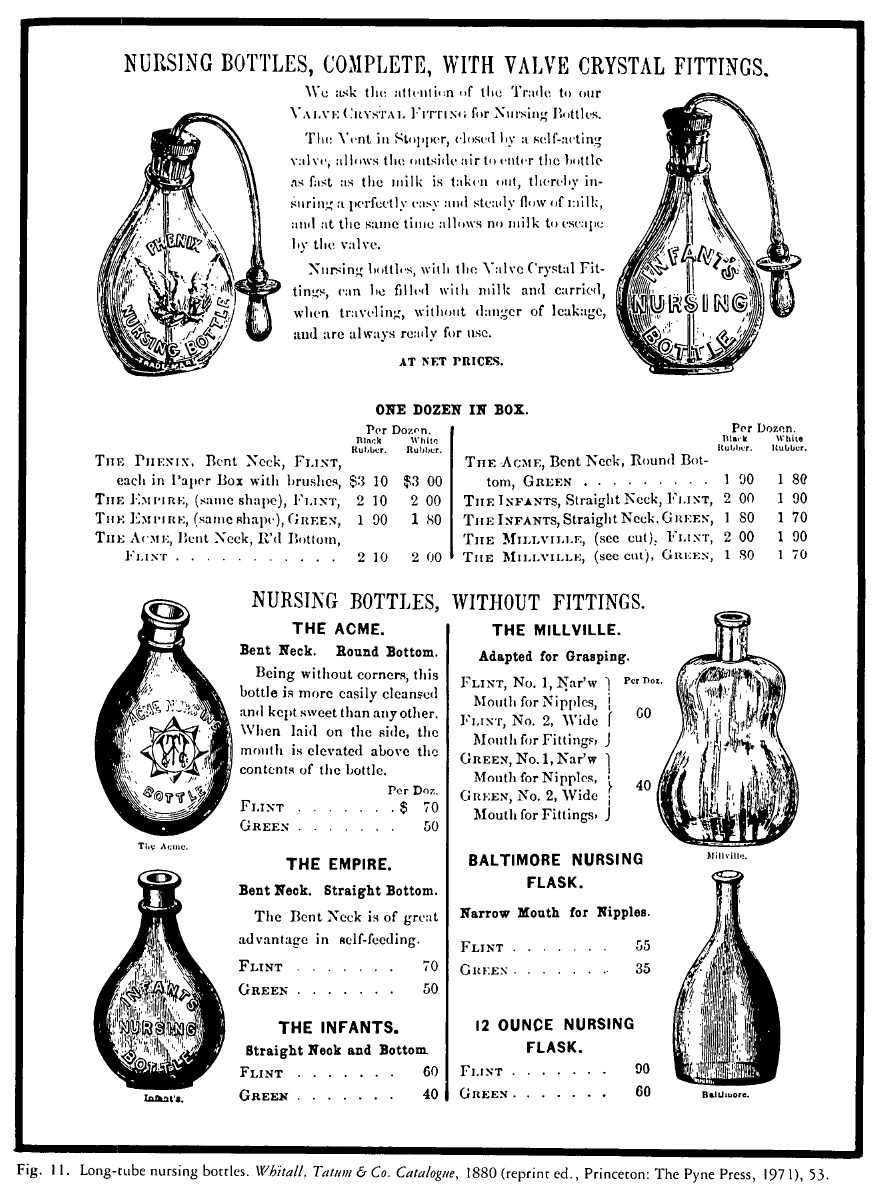 Display large image of Figure 11
Display large image of Figure 1169 Long-tube bottles and patented formulas were devices that permitted physical distance between mother and baby. They stand as evidence that progress is not inevitable and that science and technology do not always bring incalculable benefits to all.
70 Was a late nineteenth-century baby better off than ever before? Probably the answer is yes and no. Middle-class babies, for example, had more and less privacy. They had more and less freedom to move around. They were no longer dunked into cold baths to harden them, but they were no longer supposed to be fed on demand, cuddled or carried around too much. They had never been made so much of, yet perhaps never so physically distanced from the family, perhaps a separation paralleling that between work and home and worker and product in an industrial age.
71 E.P. Thompson speaks not only for the adult's world, but also for the child's when he says: "The historical record is not a simple one of neutral and inevitable historical change. Values stand to be lost as well as gained."64